Hepatitis C Blog
Greg Jefferys Hepatitis C blog deals with all the issues associated with hepatitis C
What is a Fibroscan
- April 20, 2018
- By Greg Jefferys
- 13 Comments
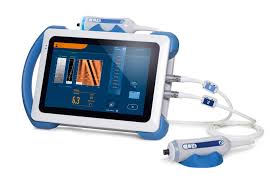
The Fibroscan replaces the liver biopsy as an effective, non-invasive, method of determining liver fibrosis levels
Fibrosis, Cirrhosis and the Fibroscan
At least once every week I get an email or FB message from someone whose doctor has booked them in for a liver biopsy to check their liver fibrosis level. From the start I want to state quite clearly that liver biopsies are not needed to determine liver fibrosis or cirrhosis.
Knowing the fibrosis level, and whether a person has cirrhosis, or not, is helpful for determining how Hepatitis C should be treated. Simply speaking the higher the fibrosis level the longer the treatment time. This is perhaps an over simplification however I will deal with this in more detail further along.
Over the past couple of years the Fibroscan has become the thing that almost everyone turns to in order to know the fibrosis level of their liver. The Fibroscan has replaced the liver biopsy as the best method of determining liver fibrosis. It is a very effective tool but there seems to be a lot of misunderstanding about how it works and how to interpret the Fibroscan results.
At EASL this year the manufactures of the Fibroscan had a stand there attended by a number of their experts. I was fortunate to be able to spend a considerable amount of time speaking with their leading expert on how the Fibroscan works. So, in this post I will try to explain, in simple terms, how the Fibroscan works and why it makes liver biopsies totally unnecessary.
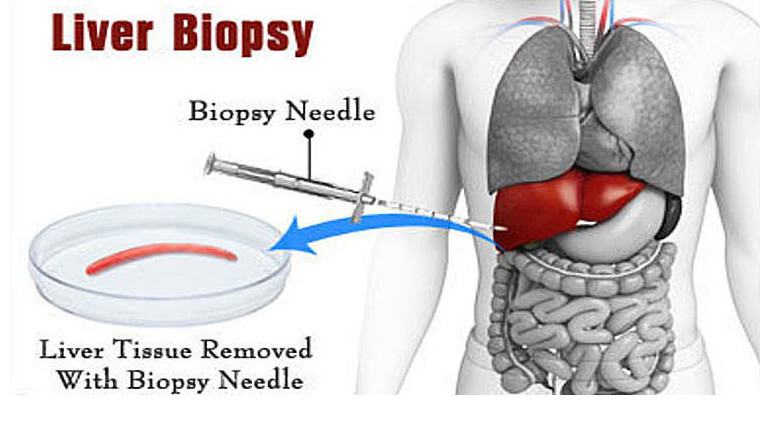
For people with Hep C a liver biopsy is not needed to determine fibrosis levels. Strangely the only two places in the world that regularly prescribe a liver biopsy are Serbia and the USA
What is a Liver Biopsy and why were they needed?
So first a little history.
For Hepatitis C treatment the purpose of a liver biopsy was to determine the level of liver fibrosis. In the case of Hep C liver fibrosis is caused by the Hepatitis C virus destroying liver cells and thus creating scar tissue. The Hep C virus “breeds” by invading a liver cell and using the generic material inside the cell to replicate itself. The virus’s presence then causes your liver cell to “explode” sending new virus particles into your blood stream where they hook onto other liver cells, invade them and repeat the process. If you have Hep C this process is happening all day every day.
There is no such thing as “dormant” or “inactive” Hepatitis C, if you have Hepatitis C it is doing some level of damage to your liver every day.
For some people this level of liver damage is low and the liver is able to heal and there is not much scar tissue formed. However, over time the scar tissue will increase. The scar tissue in the liver is like the scar tissue from a wound to a muscle, it is harder, less flexible, than the surrounding tissue. As the amount of scar tissue in the liver increases then liver becomes harder and less flexible. This is fibrosis. Fibrosis is rated from F0 to F4. At the bottom end F0 means no fibrosis (or so little as not to worry about it) and at the top end F4 means a person has cirrhosis.
If you have cirrhosis it means that your liver is pretty much a big mass of scar tissue. With cirrhosis comes increased chance of liver cancer or liver failure and death. (I was border line F3/F4 when I started treatment).
Until relatively recently the way that fibrosis level was determined was by a liver biopsy. This involved inserting a hollow needle into the liver and removing a “core” sample of the liver tissue. A biopsy is an invasive surgical procedure, that is often painful and can sometimes lead to serious complications.
Because any form of surgery is both costly and risky the Fibroscan was invented as a means of determining liver fibrosis without the need for surgery.
How the Fibroscan works
Simply put the Fibroscan is just a vibrator and a sensor.
It sends a low frequency sound wave ( called a shear wave) through the liver and measures the speed at which that sound wave passes through the liver. This is then converted into a measurement of liver stiffness measurement or fibrosis. Technically this process is often called liver ultrasonographic elastography.
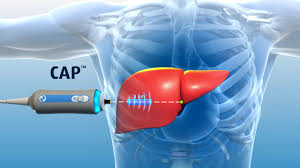
But put simply it is a liver fibrosis test.
As you see from the diagram below the Fibroscan sensor is simply held against the skin, usually placed firmly between two of the lower ribs directly above the liver.
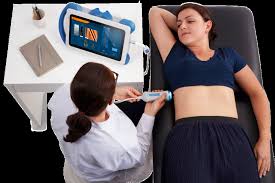
The sound is transmitted and the response measured. Usually this process is repeated about ten times in the same position to get a final reading. The entire process rarely takes more than 10 minutes.
There is no physical discomfort at all and no obvious sensation is felt from the process.
The results are available immediately and can be printed off on the spot. No waiting.
Interpreting Fibroscan Results
When the Fibroscan measure your liver fibrosis/stiffness it gives a very accurate reading and the results are recorded in quite some detail however for the purposes of easy understanding the Fibroscan results can be simplified as shown in this diagram. It is important to know that eating before doing a Fibroscan will effect the results. Generally speaking if you eat a big meal before getting a Fibroscan this will give a higher value reading. In other words it may turn an F2 reading to an F3 reading. Some people use this knowledge to access treatment when Hepatitis C treatment access is triaged based on fibrosis. For example in a lot of countries a person must have a fibrosis reading of F2 or F3 to access treatment through a government funded source or through private health insurance. So eating a big meal before the Fibroscan might just push the reading into the required zone.
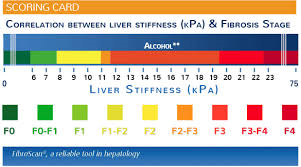
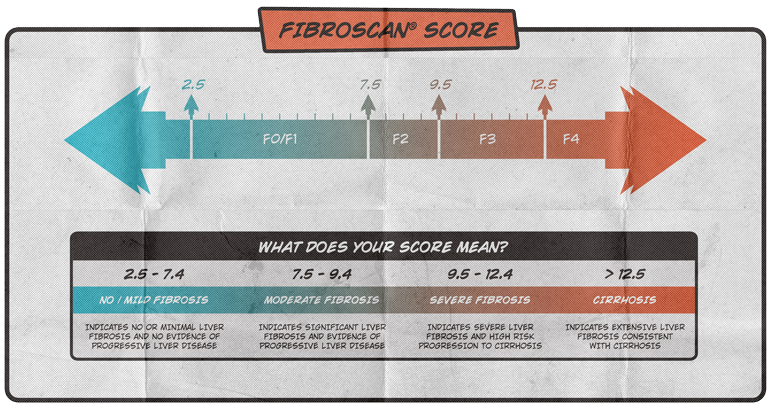
Fibroscan Accuracy, Fibroscan Alternative, Fibroscan Cap Score, Fibroscan Cirrhosis, Fibroscan Interpretation, Fibroscan Of Liver Results, Fibroscan Scale, Fibroscan Score, Fibroscan Score Card, Fibroscan Test, Fibroscan Uk
- Post Categories
- Uncategorized
Greg Jefferys
Tags
13 Comments
Leave a Comment Cancel Reply
Join my Hep C Support Group.
Talk privately to other people
with Hep C in a closed group.
Disclaimer
Greg Jefferys’ blog is provided for informational purposes and is not intended as Medical advice, diagnosis, or treatment.
Whilst Greg Jefferys is doing a PhD it is not in medicine. Any advice offered is offered in good faith and based on an extensive general knowledge of Hepatitis C and access to generic Hepatitis medicines Greg Jefferys has acquired through his work as an advocate and activist
The Hep C Buyers Club is not a company or corporate entity but simply a loose structure intended to offer a free information to people with Hepatitis C
Other Books
Click here for other books by Greg Jefferys.
for Kindle
I have converted this diary into a kindle book for folk who might like it in that format. I have added a lot more depth than the original diary contains, it’s more of a complete story in book format. I have priced it as low as Kindle allows me to @ 99 cents. If you are interested just click here to go to the Kindle page.
Recent Posts
-
Hepatitis C Treatment and Liver Cancer June 19, 2024
-
Motivate C a Profitable Hep C Initiative April 29, 2024
-
After Hep C Healthy Liver Diet September 4, 2023
-
Fear of Hep C Treatment April 14, 2023
-
My Letter to Joe Biden March 2, 2023
-
Dormant Hepatitis C November 27, 2022
-
How Much water to drink during Hep C treatment October 13, 2022
-
Hep C and Peripheral Neuropathy August 21, 2022
-
Fatigue Brain Fog and Hepatitis C August 18, 2022
-
Hep C and Liver Cancer May 18, 2022
Contact Us
If you have any questions please reach out by email, or complete the below form.
Greg Jefferys3439 Channel Highway, Woodbridge, Tasmania, 7161.
Email: gregjefferys@outlook.com



How can I request a scan be done on me?
Which country are you in Kimberley
I too would like to know how I could be scanned. I live in California US. I had an ultrasound done, and was told I had NAFLD. I never did see my results, and I feel worse…even with taking Zetia 10 mg, and N-acetylsistiene 1000mg, I had full Thyroidectomy in 11/2017 I’m 90mg Armour Thyroid. I gained 30 lbs after the surgery. I currently am on a strict mostly plant based diet, and have to exercise everyday . Despite the changes though I still feel incredibly ill.I don’t know know if you can help me, I’d appreciate anything you can deal for me.
Thank You Sincerely ,
Jennifer Bernal
Hi Jennifer
Have you had Hep C?
Beste
Vandaag heb ik een fibroscan gehad;
Nadat eerst met een bloedonderzoek de resultaten van de leverwaarden slecht waren. Di na inname van antibiotica kuur na infectie van de longen. Ik ben astma patiente en neem reeds vele jaren hiervoor medicatie. na cortisonen behandeling voor de luchtwegen en schouder kwam ik steeds bij .
En lijd ik aan overgewicht;. ik was bijgekomen tot 5 jaar geleden tot 125 kg. Dit heb ik na een dieet terug kunnen verlagen naar 103 kg, na een cortisonen behandeling vorig jaar voor de longen was ik terug bijgekomen tot 116 kg. nu heb ik dat op een jaar tijd terug kunnen verlagen naar 101,1 kg.
De leverwaarden waren terug goed na een streng leverdieet te volgen. Echter een echo van de lever gaf een leververgroting aan. Geen leververvetting.
Toch wilde mijn huisarts dat ik een fibroscan liet nemen. Deze is vandaag genomen , dit geeft toch een lichte leververvetting aan. Ook zegt de arst dat de scan veel rood aangeeft, Dat wijst eventueel op cirose zegt hij. ik rook en drink niet. Dit zou dan komen door de medictie. OOk ben ik reeds 34 jaar verpleegkundige. Ik wordt dit jaar 59 jaar.
Waarom is dan nu toch een leverbiopsie nodig ,dit geeft brengt toch nog wat risico’s met zich mee.
Kan u mij een antwoord geen.
Met vriendelijke groet
annita
Translation:::
Best
Today I had a fibroscan;
After first with a blood test the results of the liver values were bad. Di after taking antibiotics course after infection of the lungs. I am an asthma patient and have been taking medication for this for many years. after cortisone treatment for the airways and shoulder I kept coming to.
And am I overweight; I had gained weight to 125 kg until 5 years ago. After a diet I was able to reduce this back to 103 kg, after a cortisone treatment last year for the lungs I had regained it to 116 kg. now I have been able to reduce that back to 101.1 kg in a year’s time.
The liver values were good again after a strict liver diet. However, an ultrasound of the liver indicated a liver enlargement. No fatty liver.
Still, my doctor wanted me to have a fibroscan. This was taken today, this still indicates a slight fatty liver. The doctor also says that the scan shows a lot of red, which may indicate ciosis, he says. I don’t smoke or drink. This would then be due to the medication. I have also been a nurse for 34 years. I will be 59 this year.
Why is a liver biopsy necessary now, this still entails some risks.
Can you give me an answer no.
Yours sincerely
annita
I have had a ultra sound and waiting for fibro scan what could the problem be
These two types of scans should give your doctor a very clear idea of the situation for your liver. But please remember that once the Hep C is removed your liver can recover completely
that depends on the degree of liver damage
Actually Carl the liver will repair itself regardless of the degree of liver damage. If the liver is still functioning when the Hep C virus is removed then it will repair enough to regain a health function. Please read the information on this link https://www.generichepatitiscdrugs.com/liver-cirrhosis-fibrosis-hepatitis-c-good-news/
I have done a fibrosis scan of my father who is 42 years old. and the result is the following:-
LSM VALUE:- 5.8 KPA
IQR VALUE:-0.9 KPA
SR VALUE:- 100 %
CAP VALUE:- 163 DB/M
DUE TO COVId 19 I AM UNABLE TO GET DOCTOR APPOINTMENT, SO THAT IF POSSIBLE KINDLY TELL ME THE REPORT IS NORMAL: OR NOT?
The results are fine for a man with Hep C but also expected for someone in their 40’s
THANK YOU @GREG JEFFERYS. YOU have given me a very calm feeling by giving this news that report is normal.
THANK YOU ONCE AGAIN